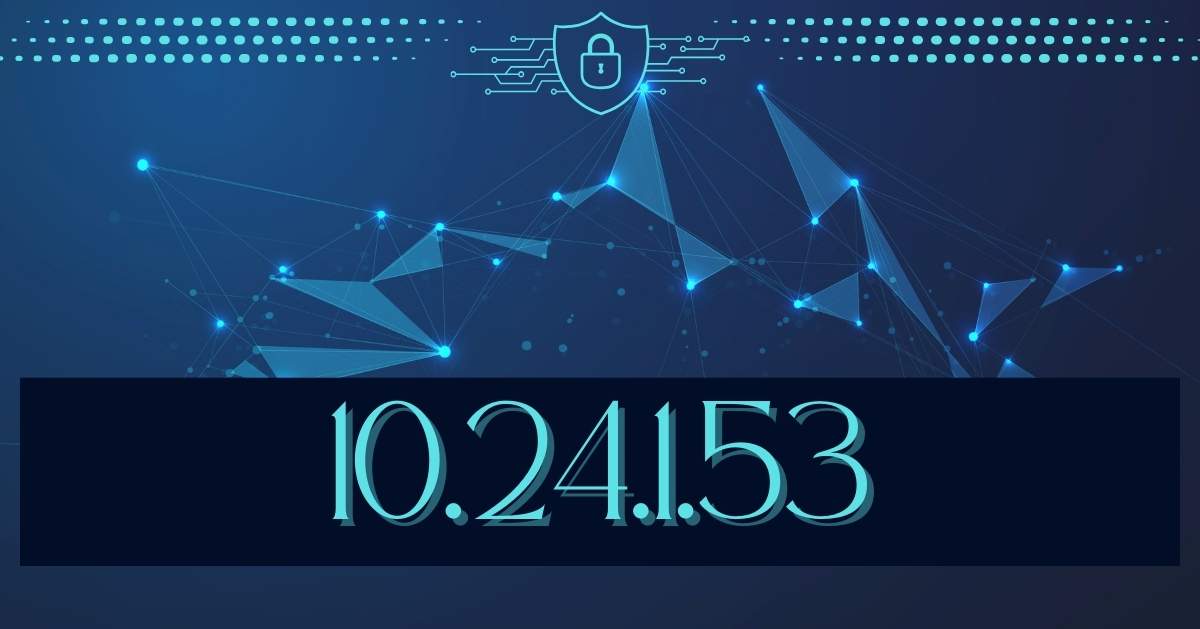10.24.1.53? Understanding Its Role in Network Configuration

Introduction to 10.24.1.53
In the ever-evolving digital world, local IP addresses play a crucial role in managing home and enterprise networks. Among them, 10.24.1.53 is a commonly used private IP address, often utilized for accessing router settings or managing devices within a LAN (Local Area Network). If you’ve stumbled across this IP or have been asked to log in via it, this comprehensive guide will explain what it is, how it works, and how to manage it safely.
What Is a Private IP Address?
Private IP addresses are reserved for internal use within networks and cannot be accessed directly from the internet. These include IPs starting with:
- 10.0.0.0 to 10.255.255.255
- 172.16.0.0 to 172.31.255.255
- 192.168.0.0 to 192.168.255.255
These ranges are defined by RFC 1918, which is a standard established by the Internet Engineering Task Force (IETF) to prevent address conflicts and maintain efficient routing within closed networks.
Why Use Private IPs?
- Avoid IP conflicts on the public web
- Maintain a secure and isolated environment
- Allow multiple devices to share a single public IP via NAT (Network Address Translation)
Understanding the Role of 10.24.1.53
The IP address 10.24.1.53 is part of the 10.0.0.0/8 private IP block. It is typically assigned to devices like:
- Routers
- Switches
- Access points
- Network printers
- IoT devices
It can also be used as a gateway IP, which allows users to access administrative settings of the device it’s assigned to. However, 10.24.1.53 isn’t universally fixed to a specific brand or model—it depends on your specific network configuration.
How to Access 10.24.1.53
Step-by-Step Instructions:
- Connect to the Network:
Ensure your computer or mobile device is connected to the same local network. - Open a Web Browser:
Chrome, Firefox, Edge—any will work. - Type 10.24.1.53 in the Address Bar:
Hit Enter. You should be prompted to enter a username and password. - Log In:
Use the credentials provided by your network admin or found in your device’s manual. Common defaults are:- Username: admin
- Password: admin or password
- Username: admin
- Access the Settings Panel:
Once logged in, you can configure network settings, update firmware, or monitor traffic.
Note: If 10.24.1.53 doesn’t load, the device might not be using that IP anymore. You can check your device’s IP through ipconfig (Windows) or ifconfig (macOS/Linux).
Common Uses of 10.24.1.53 in Network Management
1. Router Configuration
Administrators may use 10.24.1.53 to:
- Change Wi-Fi SSID and password
- Set up port forwarding
- Update security settings
- Monitor device activity
2. IoT and Device Setup
Printers, smart cameras, and other IoT devices often operate under fixed IPs for stability. Using 10.24.1.53 helps identify and access those devices easily.
3. DHCP and Static IP Mapping
In networks with multiple users or departments, assigning 10.24.1.53 as a static IP can streamline maintenance and avoid conflicts.
Troubleshooting 10.24.1.53 Access Issues
Page Not Loading
Solution:
- Check if your device is on the correct network
- Run ping 10.24.1.53 to see if it’s reachable
- Reboot your router or modem
Incorrect Credentials
Solution:
- Try default credentials
- Contact your ISP or network administrator
- Perform a factory reset (as a last resort)
IP Conflict or Changes
Solution:
- Use ipconfig or check your router’s admin panel
- Look under connected devices to see if 10.24.1.53 is still in use
Security Tips for Managing 10.24.1.53
Ensuring your internal IP setup is secure is just as vital as public-facing defenses. Here are some best practices:
1. Change Default Credentials
Default usernames and passwords are widely known. Always set a strong, unique password.
2. Enable WPA3 or WPA2 Encryption
If accessing 10.24.1.53 to configure Wi-Fi settings, ensure the encryption type is not outdated like WEP.
3. Update Firmware
Router and device manufacturers release firmware updates to fix vulnerabilities. Regularly check and apply them.
4. Disable Remote Access
Unless necessary, turn off remote management options to avoid unauthorized access from external networks.
When to Contact Your 10.24.1.53 Network Administrator
If 10.24.1.53 seems inaccessible or you’re unsure about changing settings, it’s best to consult your network administrator. Signs you need expert help include:
- Multiple failed login attempts
- Devices constantly losing connection
- IP conflicts causing network disruptions
- You’re unsure about advanced settings like QoS, port forwarding, or firewall rules
Conclusion
The IP address 10.24.1.53 is a powerful tool for managing devices within a private network. Whether it’s used for configuring a router, accessing IoT equipment, or organizing static IP assignments, understanding its function helps ensure smoother network performance and enhanced security. By following the right access steps, maintaining good security hygiene, and knowing when to seek help, you can fully leverage 10.24.1.53 for both home and enterprise environments. As with all network tools, knowledge and caution go hand in hand to keep systems running efficiently and safely.
FAQs
It is a private IP address from the 10.0.0.0/8 range, used for internal networks.
Ensure you’re connected to the correct network and check for IP conflicts or device changes.
Yes, if you have access to the network admin panel, you can assign a new static IP or use DHCP.
Routers, printers, switches, access points, or any LAN-connected device might use this IP.
Yes, as long as you follow standard network security practices like strong passwords and firmware updates.







One thought on “10.24.1.53? Understanding Its Role in Network Configuration”